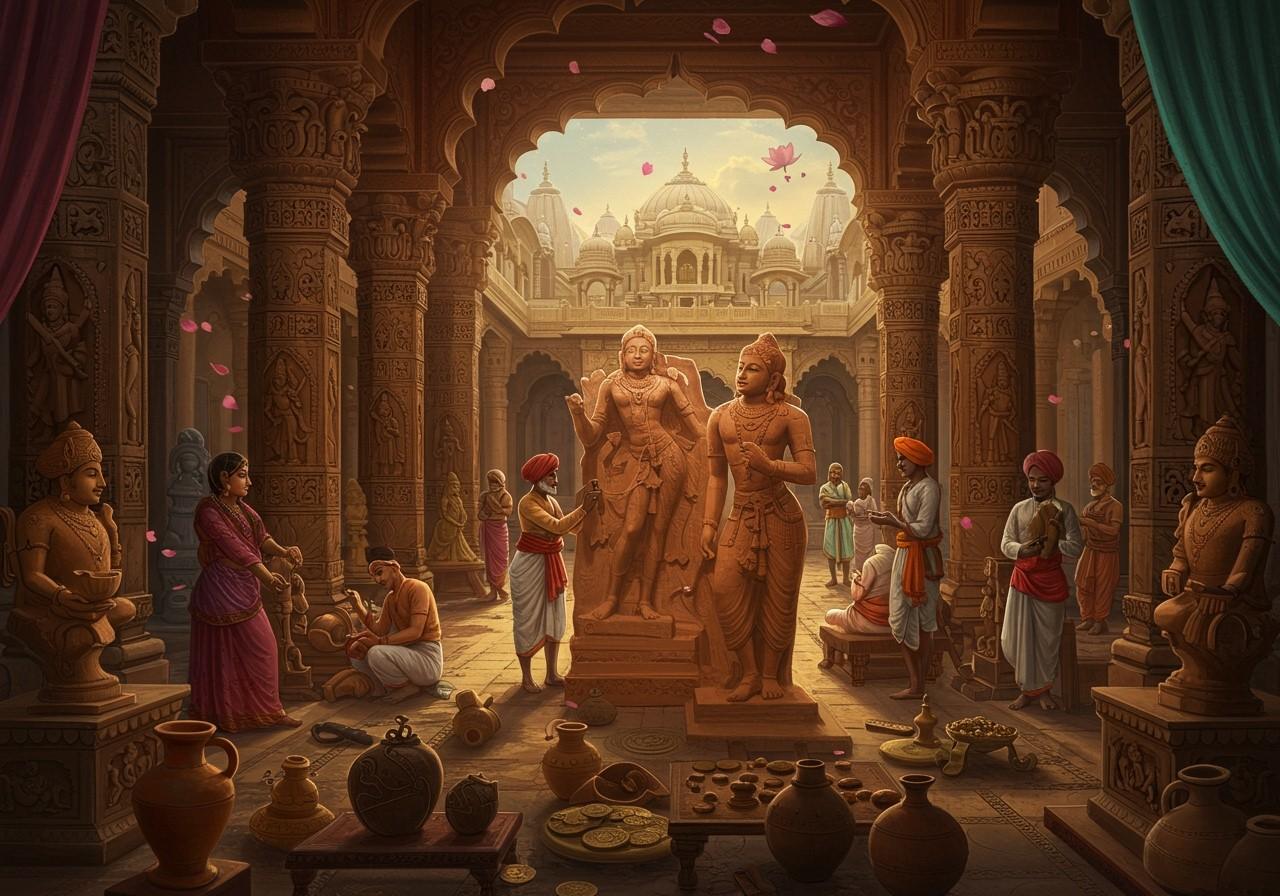
The Shunga period (circa 185 BCE to 73 BCE) in Indian history is a captivating era marked by substantial cultural, political, and artistic transformations. Succeeding the Maurya Empire, the Shunga Dynasty, established by Pushyamitra Shunga, oversaw a period of artistic flourishing, particularly in Buddhist art, despite initial hostility towards Buddhism. Understanding this era is crucial for grasping the historical and cultural evolution of ancient India.
Historical Overview
The Shunga Dynasty emerged after Pushyamitra Shunga assassinated the last Mauryan emperor, Brihadratha. This act of rebellion marked a pivotal shift in power. The nascent empire encompassed regions of present-day Madhya Pradesh, Uttar Pradesh, and Bihar.
Pushyamitra Shunga’s reign involved strategic battles and military campaigns to solidify his authority. The Shunga administration retained some Mauryan administrative practices while introducing new elements. Importantly, the Shunga rulers played a crucial role in defending the Indian subcontinent against foreign incursions, particularly from the Indo-Greeks.
Key Figures of the Shunga Dynasty
Several rulers shaped the Shunga Dynasty’s trajectory:
- Pushyamitra Shunga (circa 185 BCE – 149 BCE): The dynasty’s founder, renowned for establishing and expanding the empire through military prowess and strategic alliances.
- Agnimitra (circa 149 BCE – 141 BCE): The second ruler, known for his patronage of the arts and literature, fostering a vibrant cultural atmosphere.
- Bhagabhadra (circa 110 BCE – 83 BCE): Remembered for his diplomatic relations with foreign powers, notably evidenced by the Heliodorus pillar, erected during his reign, signifying interactions with the Indo-Greek ambassador Heliodorus.
These rulers significantly influenced India’s cultural and political landscape.
Cultural Aspects of the Shunga Period
The Shunga period witnessed a resurgence of Hinduism, although Buddhism continued to thrive, especially under the patronage of later Shunga rulers. This era saw the development of a distinctive artistic style, known as Shunga art, which drew inspiration from folk traditions and incorporated Buddhist concepts. Shunga art differed significantly from the more elitist Mauryan art, showcasing a broader range of subjects and perspectives.
Architectural Achievements
The Shunga period is notable for its architectural contributions, including stupas, viharas (monasteries), and chaityas (prayer halls).
- Bharhut Stupa: Famous for its intricate carvings depicting Jataka tales – stories of the Buddha’s previous lives – offering valuable insights into Buddhist beliefs and narratives.
- Sanchi Stupa: Though its origins predate the Shungas, it underwent significant expansion and embellishment during this period, further solidifying its importance as a Buddhist pilgrimage site.
Shunga Art
Distinct from the preceding Mauryan art, Shunga art embraced folk traditions and synthesized them with Buddhist ideals. This fusion resulted in a unique style characterized by detailed and expressive sculptures, often depicting scenes from daily life, mythology, and religious themes.
- Sculptures: Shunga sculptures are known for their dynamism and expressiveness, capturing a wide range of human emotions and activities. These sculptures often adorned stupas and other religious structures, adding to their visual richness and narrative power.
- Terracotta Figurines: The Shunga period also saw the production of numerous terracotta figurines, which provide glimpses into the everyday lives of people from different social strata. These figurines often depict deities, animals, and scenes from daily life.
Literary Contributions
Literary activities flourished under Shunga patronage. While the exact dating of Kalidasa remains debated, the Shunga period and the succeeding Satavahana period are often associated with his works. The period set the stage for later developments in Indian art and architecture, particularly influencing the Gupta era.
Bhagabhadra’s Reign (circa 110 BCE – 83 BCE)
Bhagabhadra’s rule was marked by significant cultural and diplomatic achievements. His establishment of robust diplomatic ties with foreign powers is evidenced by the Heliodorus pillar inscription, which attests to his interactions with the Indo-Greek ambassador Heliodorus. This period fostered cultural exchange, contributing to the richness and diversity of Shunga art, literature, and religious practices. Bhagabhadra’s policies also positively influenced the socio-economic conditions of the Shunga Empire.
Connecting with Shunga Period Heritage through Poojn.in
Poojn.in, India’s leading online store for cultural and religious goods, offers a unique opportunity to connect with the rich heritage of the Shunga period. Explore our collection of authentic ritual items:
- Traditional Clay Lamps (Diyas): Similar to those used in Shunga-era temples, these diyas bring a touch of ancient sanctity to your home. Crafted with care, they illuminate your space with a warm, inviting glow, reminiscent of ancient rituals.
- Pure Copper and Brass Vessels: Reflecting the rich metalwork traditions of ancient India, these vessels are ideal for traditional ceremonies and rituals. Their exquisite craftsmanship and durability make them cherished heirlooms.
- Handcrafted Ritual Items: Made using techniques passed down through generations, these items connect you with the artistic legacy of the Shunga period. Each piece is imbued with a sense of history and tradition.
Poojn.in ensures authenticity and convenience:
- Detailed product descriptions with historical context enhance your understanding and appreciation.
- Genuine materials, traditionally used in worship, ensure the integrity of your spiritual practice.
- Secure packaging safeguards delicate ritual items during transit.
- Pan-India delivery with careful handling ensures your items arrive safely.
- Expert guidance on proper usage of ritual items provides support and clarity.
Visit Poojn.in to discover a wide selection of authentic ritual items that help preserve the traditions of India’s Shunga period. Our products support your spiritual practices while honoring historical authenticity. (Product availability may vary. Please check the website for current stock.)
Conclusion
The Shunga period (circa 185 BCE – 73 BCE) remains a remarkable chapter in Indian history, distinguished by significant cultural, artistic, and architectural achievements. The Shungas’ revival of Hinduism, coupled with their patronage of Buddhist art, created a unique cultural blend that enriched India’s heritage. From the architectural marvels like the Bharhut Stupa to the intricate sculptures, the Shunga period’s legacy continues to inspire and inform our understanding of ancient India.


